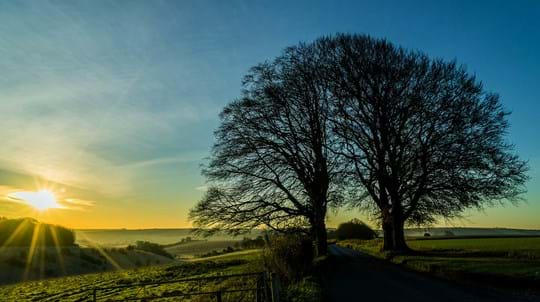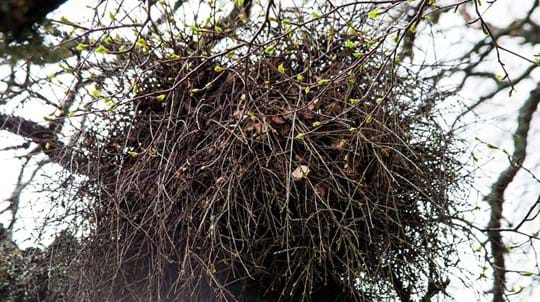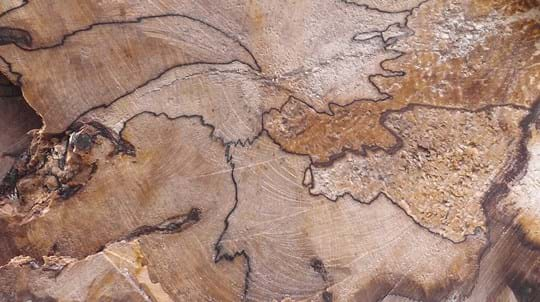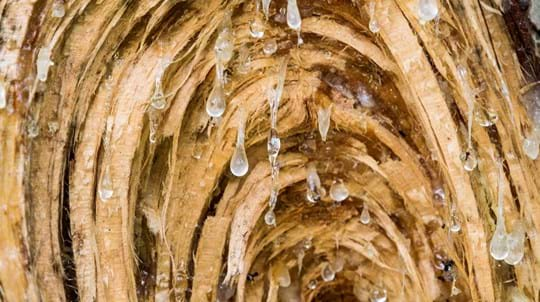
Go exploring
Primordial landscapes, tangled branches, breathtaking wildlife and miles of woodland trails. From the countryside to cities, we care for thousands of woods throughout the UK, all free to visit.
Find a wood near you
Public enquiries officer
Trees aren’t just homes for wildlife – they can also host a range of spots, patches, powders, lumps and bumps!
They are usually nothing to worry about, but it’s interesting to learn what’s growing and why. Here’s our quick guide to some of the more common fungi, growths, colour changes and reactions to damage.
Mildew can be a common sight on plants and trees, especially in warm and damp conditions. The mildew that affects trees has the same appearance as the mildew that you can often find in gardens, so it’s easily recognisable. Mildew is the common name given to a few different fungi, and it appears as a white residue. If you rub an affected leaf between your fingers you should see a white powder residue left on your hands.
Generally, a tree with mildew can be left alone. Mildew is a natural consequence of our weather and should die off over winter. In young saplings, mildew will stunt growth. You can spray the tree with a fungicide, but we’d recommend waiting until next spring to see if it clears up on its own.
Another common fungus is the black spots on sycamore leaves called tar spot (Rhytisma acerinum). It doesn’t look very nice, but it’s nothing to be concerned about and there is no treatment. If the tree is in your garden, you can gather up fallen leaves and burn them in autumn to try and prevent the fungus spreading.
Galls are odd growths that come in a variety of shapes and sizes. The term 'gall' covers a whole range of different plant deformities caused by organisms including:
Many of the odd growths you spot on a woodland tree are probably a type of gall.
There is a lot we don’t know about galls. They’re a niche subject and don’t attract a lot of research attention. Most galls don't cause any long-term damage to trees, though some can pose a threat, like those caused by the oriental chestnut gall wasp.
Some common galls have their own name, but many are known only by the organism that causes them.
In the UK, many varieties of algae grow on trees, often visible as a green or red film on the bark.
The most common algae come from a group called Trentepohlia. These species appear on trees and other outdoor surfaces in bright colours, from orange to rusty red. They appear as a 'film' that can cover part or all of the trunk's surface and tend to be most prevalent on the northern side of a tree (where it gets the least sun). The colour is caused by the pigment in the algae, which is a carotenoid – the same thing that makes carrots orange. The orange staining can be very vivid, and is particularly visible in winter when trees are bare.
Like lichens, algae are sensitive to moisture. They’re more likely to be found on rough, textured bark where trapped rain creates an ideal damp habitat. Algae is predominantly associated with oak, ash and beech, and is more common in the south of the UK.
Algae doesn’t harm trees - it’s just using the surface to grown on. They may appear by themselves or as part of a lichen.
Trees can suffer damage by a number of causes, including fungi, bacteria, viruses, weather, insects, animals and humans. Sometimes they succumb to the attack, but sometimes they fight back to protect themselves. You can’t always see how trees react to damage, but two responses are particularly visible: burrs and bacterial tree ooze.
You may have noticed trees with a strange knobbly growth or two on their trunk. They're easy to spot once you start looking! This abnormal growth is called a burr. In American English it’s known as a 'burl', so you may find it referred to as both.
The growth is a mass of shoot and bud tissue that grows manically and forms a distinctive growth on the trunk. At its most basic, it's not unlike a benign tumour in an animal.
Burrs are thought to be a response to stress, but the stressor can be difficult to identify. The growths usually form over a wound which heals over during the period of irregular growth, protecting the tree from further damage at that site. Burrs don’t cause any harm to the tree.
Bacterial ooze on trees doesn’t appear common in the UK, but you’d recognise it if you saw it – it looks like slime.
Like all plants, trees have an immune system which should protect them from severe infections. But in some circumstances, if the bacteria can feed on the tree sap and nothing prevents it from multiplying, it will eventually form this slime. Bacterial oozes are often fatal, rotting the tree as the bacteria 'eats' it and ultimately leading to tree death.
Without knowing what bacteria is causing the problem, it’s difficult to know how contagious it is. The bacteria involved are often present in a woodland anyway without causing any problems. As the ooze usually forms when specific conditions occur on a tree, it shouldn’t spread in woodland.
Bacterial oozes may be accompanied by other pathogens that further harm the tree. For example, slime flux is a type of bacterial ooze that is a mix of bacteria and yeast. It has quite a distinctive orangey-yellow appearance. The yeast and bacteria ferment the tree sap, leading to an unpleasant smell and attracting insects to the ooze.
If you spot a tree with bacterial ooze on it, we recommend you let the owner know. The rot can weaken the tree, so they may need to check it is safe. Please also fill out a Tree Alert form to help track the prevalence and spread of bacterial ooze around the UK.

Primordial landscapes, tangled branches, breathtaking wildlife and miles of woodland trails. From the countryside to cities, we care for thousands of woods throughout the UK, all free to visit.
Find a wood near you
Trees woods and wildlife
Everything you need to know about British trees. From identification, folklore and history to the pests and diseases that threaten them.

Blog
Kylie Harrison Mellor • 24 Apr 2019

Blog
Annabel Kemp • 12 Nov 2024

Blog
Julia Lock • 29 Dec 2021

Blog
Charlotte Varela • 20 May 2024